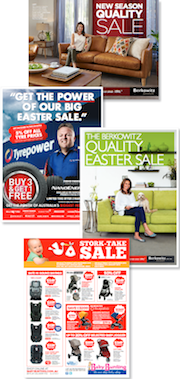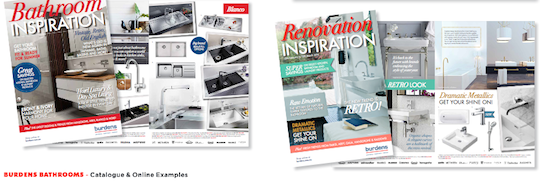The five elements that make retail promotions successful
Share
Dino Bruni walks us through the five elements successful retail promotions.
To understand the fundamental elements of retail advertising you need to accept its primary objective, which is to bring new customers to your online or physical store location. Talking to existing customers is fine, but you will never increase your brand’s market share by only targeting existing customers.
Don’t get me wrong, growing sales from existing customers by reaching them with regular eDMs, social media, digital banner ads and retargeting is important, but too many marketers put too much effort and expense targeting their own customers and fail to understand that new customers are the lifeblood of every retailer. Retailers open for business every day and need the influx of new customers to grow their brands and balance the loss of existing customers that might switch brands or simply die off as they age.
The fundamentals of growing new customers are rooted in the fundamentals of retail. You have to start with the audience. Who are they, what are they looking for, what motivates them to buy from you, and what are the most effective ways to reach them?
1. Develop a retail brand positioning that differentiates the brand
Anyone can develop a new retail positioning, but the most successful are based on the essence of the retail brand (normally found in why it was established in the beginning) and motivates the customer on more than just price.
If retail advertising is only about promoting products at a best price, then it’s game over, especially in today’s tech driven world. It’s now possible for retailers and brands to get a live view of retail pricing by brand and product, so price is no longer a differentiator.
The retail brands that crush their competition are those which understand that strategic brand differentiation goes much deeper than product/price and pretty visuals.
Branding is layered, sculpted, and tested
To create a layered, brilliant, and competitive retail brand, three things must align.
- Understanding of your brand,
- Understanding of your best potential audience, and
- Understanding, and differentiating from, your competition.
Combined, these elements create brand magic and that’s how we differentiate our retail clients. Tyrepower is a classic example. When we were first appointed research indicated that Tyrepower ranked well outside the top three for ‘intent to purchase’. This was of particular concern for a business in the tyre category where customers rarely shopped more than three retailers to find the best deal.
Strategy
The objective was to develop a unique creative platform for the brand that drives home key messages to get Tyrepower on the shopping list. The campaign needed to be fully integrated across all communications media to ensure that, no matter where, the audience was exposed to a Tyrepower ad, the brand message was consistent.
Execution
Following an extensive qualitative and quantitative research process reviewing the market and target audience, and concept testing, the agency created a brand and retail campaign with the line: ‘Get the power of Australia’s biggest independent.’
The Tyrepower store owners were used to further differentiate the brand. The Tyrepower store owners were seen as real, friendly, credible and trustworthy (as opposed to polished,
professional actors). This helps drive the ‘independent’ positioning for the brand versus the publicly listed corporate retail brands in the category. And, while the TV ads are scripted, the owners’ delivery of their lines is honest and genuine, ‘warts and all’.
Outcome
We can’t publish the results, but needless to say the Tyrepower brand and retail campaign is still running and evolving today because the brand’s positioning is so well differentiated.
2. Get on the shopping list
To get on the ‘shopping list’ your brand needs to in the top three unprompted brands the audience associates with a specific category of retailing. If your brand is not mentioned in this top three, then you’re in serious trouble.
So how are you going to get on the shopping list?
Well you’re not going to get on new customer’s shopping lists with just a Facebook update, search result, eDM or digital banner campaign.
Work out who your target market is and then reach as many as possible, as often as possible with the biggest share of your marketing dollars on activity that delivers high
reach and quickly. That’s important because retail events only run for two or three weeks so it’s best to go where the biggest audiences are and that means using a mix of television, radio, catalogues, and online (social media), and in that order depending on your budget.
Some marketers will be groaning about the wastage of mass media platforms, but think about all the new customers you’re now reaching in a small promotional window. Mass marketing drives new retail customer acquisitions.
Remember the funnel diagram of customer acquisition and activation from university days. The top of the funnel is all about brand awareness and consideration. Only mass media platforms drive the ‘eyeballs’ you need quickly to reach the audience during a short retail event.
As you move down the funnel the activation campaigns kick in to direct customers to your store. But retail activations only work when a brand has capitalised on increased awareness and consideration generated by a mass media campaign.
Screen based culture
Video content is still the best tool to drive store traffic. Video is more engaging and delivers better branding for retail events. We watch everything on our screens; on mobile, desktop or smart TV – it all happens on a screen.
Today we read our newspapers, listen to music, open apps and obviously watch movies on big and small screens everywhere. Having said that, the platform that still delivers the most eyeballs quickly is free to air and pay TV.
TV advertising is brilliant at creating successful brands, both overnight and over the long-term. It drives more media-driven sales than any other communication channel and works brilliantly when supported by radio advertising.
Catalogues can also be viewed on screens either via a retailer’s website, catalogue platforms like Lasoo, or within expanding rich media digital executions.
Catalogue advertising is another mass audience option for retailers to get on the shopping list. We drop almost a million printed catalogues in Victoria for our client Burdens Bathrooms to support a retail event.
The catalogue does have wastage, but if you print enough copies you’ll also have mass reach and that drives massive sales.
(Note: You can use customer post code data to target certain demographics or MOSAIC
profiles across Australia in order to increase the impact and cost efficiencies of the catalogue campaign).
Boost printed catalogue effectiveness by leveraging Facebook
Through sophisticated data matching, you can now identify your customers that fall in and out of catalogue catchments and target these customers directly via Facebook. You can upload your customer’s email database directly into Facebook and see where emails match to create a new targeted audience.
An audience that receives a printed letterbox delivered catalogue and a digital
Facebook campaign. The letterbox catalogue and Facebook ads both impact the audience in the same week of the retail promotion. Overlay an eDM burst and you’ve now reached your audience three times in the one week, and that’s a clever way to drive retail event.
Roy Morgan highlights that across all categories measured for ‘media most useful for making a purchasing decision’, catalogues and digital advertising rank in the top 3 with television of the 25 categories measured.
Catalogues are a must use marketing tool to showcase a retailer’s product and service offerings. Reaching mass audiences is the only way to get your retail brand top of mind or at the very least in the top three brands customers think of when thinking about the retail category you compete in.
Catalogues not only drive sales but also improve retail brand attitudes; Latest research shows that 31% of consumers who viewed a catalogue said the content gave them fresh information about a brand.*
3. Build a promotional calendar
 Retail is cyclical. It runs on a 12 month calendar (or equivalent) set into periods of time that make sense to the retailer.
Retail is cyclical. It runs on a 12 month calendar (or equivalent) set into periods of time that make sense to the retailer.
Within this cycle, there are usually perennial sales periods, themes and properties that the retailer can build their marketing calendar around. There are the obvious ones like Christmas, Easter, and School holidays and others like ‘The Great Race Sale’, Stocktake Sale’, or my favourite, the ‘Birthday Sale’, there’s lots to choose from.
Smart retailers like our client Berkowitz Furniture create their own promotional retail event calendar and that helps to not only differentiate the brand but create excitement that something is happening in store and that drives foot traffic.
4. Make the sale today and build the brand for tomorrow
Every retail event needs to drive store traffic with competitive retail offers. But you also need to allocate marketing expenditure to building the brand.
Sometimes you can communicate brand benefits and sale offers in the same communication, but in most cases you need to have a retail offer in the market place
backed up with a consistent brand message.
Our retail clients drive monthly retail events with strong retail offers across television, radio and online, but we also support these events with brand communication which represents approx. 20% of the total retail event budget.
Typically we use digital and radio activity to support these retail events to further drive activation, and ultimately, sales. That way we drive sales for the monthly event while investing in the brand values and strengths that build the brand for the future.
5. Bring it to life instore
Whatever you are doing in comms, the store is where the rubber meets the road. Link the advertising with the point of sale.
If you have a standalone store fronting the street communicate the retail event theme using large window posters that support mass media, digital and social and tell the consumer that there’s something new happening to encourage them to come in and buy.
Campaigns should also live instore, not just in the outside world, and having enticed shoppers to your store, you want to give them an outstanding experience in terms of presentation of the range and your branding. Making it work hard in this space will drive repeat visitation and word of mouth endorsement.
Dino L Bruni is director of Bruni Dunn Creative
















